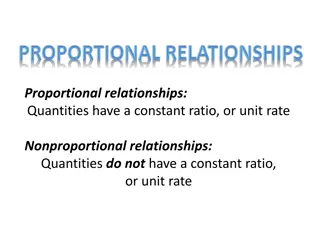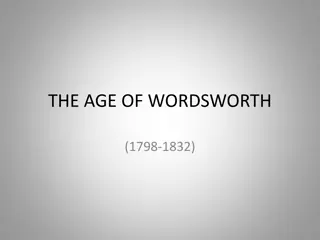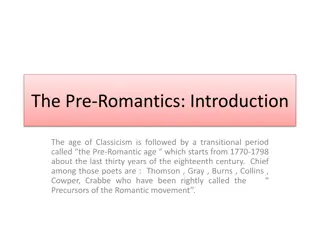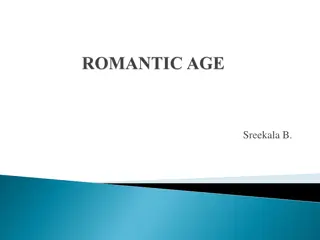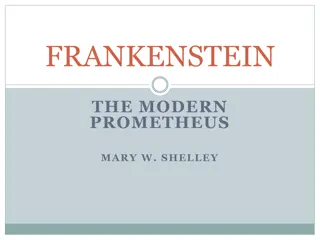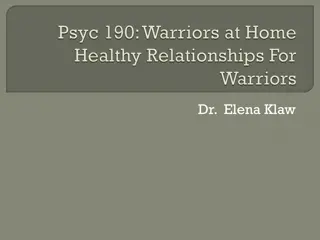Navigating Romantic Relationships in College
Exploring the dynamics of romantic relationships in a college setting, this content delves into what draws people together, communication challenges, gender differences in sex receptivity, and the factors that influence physical attraction and relationship longevity.
Uploaded on Sep 27, 2024 | 0 Views
Download Presentation

Please find below an Image/Link to download the presentation.
The content on the website is provided AS IS for your information and personal use only. It may not be sold, licensed, or shared on other websites without obtaining consent from the author.If you encounter any issues during the download, it is possible that the publisher has removed the file from their server.
You are allowed to download the files provided on this website for personal or commercial use, subject to the condition that they are used lawfully. All files are the property of their respective owners.
The content on the website is provided AS IS for your information and personal use only. It may not be sold, licensed, or shared on other websites without obtaining consent from the author.
E N D
Presentation Transcript
ROMANTIC RELATIONSHIPS IN COLLEGE: THE GOOD, THE BAD, AND THE UGLY Sarah Steinmetz, B.A. University Counseling Center University of Colorado at Colorado Springs
WHAT ARE WE GOING TO TALK ABOUT? What draws people together? Sex Sexual Assault What makes people stay together and what breaks people up? Communication Domestic Violence Same-sex couples
GETTING INTO A RELATIONSHIP Physical attraction, Personality characteristics
WHY AM I PHYSICALLY ATTRACTED TO THIS PERSON? Cultural Conventions (Berry, 2000) Symmetry (Scheib, Gangestad, & Thornhill, 1999) Mathematical averageness (familiarity) (Rhodes, 2006) Sexual Dimorphism (Anitei, 2007) Phi mask ratio (1:1.618) (Marquardt)
WHY AM I ATTRACTED TO THIS PERSON? (SPRECHER & REGAN, 2002) Casual Sex Partner 1 ---------- 3 ---------- Dating partner Marriage partner Warmth/kindness Expressiveness/openness Sense of humor Similarity of values/attitudes Exciting personality Sexual passion 1 2 3 -------- 1 2 3 4 4 2 4 -------- -------- --------
SEX Receptivity, What is sex?, Frequency, Satisfaction,
GENDER DIFFERENCES IN SEX RECEPTIVITY (CLARK & HATFIELD, 1989) Attractive man or woman approached stranger on college campus. I have been noticing you. I find you attractive .. Women Men Would you go out with me tonight? 50% 50% Would you come to my apartment? 6% 69% Would you go to bed with me tonight? 0% 75%
WHAT IS SEX? (NATIONAL CENTER OF FAMILY GROWTH SURVEY) had sex if engaged in following behavior: Males 1.4% 11.6% 37.3% 99.% Females 2.9% 17.1% 43.9% 99.2% Deep kissing Touching genitals Oral with genitals Intercourse
FREQUENCY OF SEXUAL ENCOUNTERS (NATIONAL CENTER OF FAMILY GROWTH SURVEY) Age 20-24 In the last year Males 9% 7% 49% 32% Females 9% 5% 61% 24% Never had sex No sex in past 12 months Had sex with 1 partner Had sex with more than 1 partner
HOW MANY PEOPLE HAVE SLEPT WITH HOW MANY PEOPLE? (ALEXANDER & FISCHER, 2003) Number of sexual partners in lifetime exposure anonymous Bogus lie detector Male 3.7 4.2 4.0 Female 2.6 3.4 4.4
SEXUAL SATISFACTION (OKAMI & SHACKELFORD, 2001) How often does you or your partner have an orgasm? Males 75% 44% Females 29% 78% I always have an orgasm with my partner My partner always has an orgasm with me
TAKE AWAY POINTS FROM GETTING INTO A RELATIONSHIP AND SEXUAL STATISTICS Understand that your expectations may be different from the other person s expectations. Be clear in what you want, need, and expect to get out of the relationship.
SEXUAL ASSAULT Statistics, Consent, Safety plan, How to help a friend
SEXUAL ASSAULT STATISTICS In 2003, one in ten victims of sexual assault were male (National Crime Victimization Study, 2003) 44% of sexual assault victims are under the age of 18 (National Crime Victimization Study, 1999) Responses collected from the National Women's Study show 84% of rape victims never reported the crime at all 1 in 4 women in Colorado have been victims of one or more forcible, completed rapes (CDPHE Injury in Colorado Report 2005) 1 in 20 Colorado men have experienced a completed or attempted sexual assault (CDPHE Injury in Colorado Report 2005) 4/5 women were raped by someone they knew
CONSENT AND SEXUAL ASSAULT Give approval and to agree by free will Based on choice Active, not passive Possible only when there is equal power Both parties must be equally free to act Colorado Law requires that consent for sex be ACTIVELY given!
SAFETY PLAN For Men For Women If you re getting mixed messages: stop, ask, clarify Be clear about sexual limits Use both words and actions to convey these limits Be clear about your own sexual limits Trust your instincts Not worth going to jail! REPORT No, always means NO. So does, maybe , I m not sure , another time , etc. An enthusiastic yes always means yes, from a SOBER person
HOW TO HELP A FRIEND Listen Believe Support Challenge myths and stereotypes (because the victim also endorses them) Challenge oppression Don t blame the victim
WHAT MAKES A RELATIONSHIP SATISFYING? 3 most damaging things to a relationship, Personality characteristics, Illusions, Ratio of positive to negative, Commitment.
3 MOST DAMAGING BEHAVIORS TO RELATIONSHIPS! (NATIONAL CENTER OF FAMILY GROWTH SURVEY) #1 Violence #2 Infidelity #3 Alcoholism
PERSONALITY CHARACTERISTICS AND SATISFYING RELATIONSHIPS (ROBINS, CAPSI, & MOFFIT, 2000) Women report more happiness in a relationship when their partners are low in negative emotions, high in positive emotions, and high in constraint. Men report more happiness in a relationship when their partners are low in negative emotion. Negative emotions = stress reaction, alienation, and aggression. Positive emotions = well-being, social potency, social closeness, and achievement. Constraint = control, harm avoidance, and traditionalism.
BENEFITS OF POSITIVE ILLUSIONS? (MURRAY, HOLMES, & GRIFFIN, 1996) Positive illusion of the person need to idealize the person and how good the relationship is. People outside of the relationship can actually better predict the relationship outcome than the couple themselves. People stay with people who view themselves as the same way they view themselves. Negative illusions attributing your partners faults as a inherent trait rather than external stressors they are responding to.
WHAT MAKES RELATIONSHIPS WORK? (RUSBULT, WIESELQUIST, FOSTER, & WITCHER, 1999) Stable relationship = 5:1 ratio of positive to negative. (Gottman) Level of Rewards costs Satisfaction
WHATMAKESARELATIONSHIPWORK? (LEE & AGNEW, 2003) Investment .48 Commitment Alternatives -.52 Satisfaction .71
COMMUNICATION Positive and negative sequences and how to get out of the habit of negative sequences.
COMMUNICATIONSEQUENCESANDTHEIR EFFECTONTHERELATIONSHIP(KELLY, FINCHAM, & BEACH) Negative/Positive Reciprocity Escalation Demand/withdraw 4 horsemen of the apocalypse (Gottman, 2002): Criticism Contempt Defensiveness Stonewalling
COMMUNICATIONTAKE-AWAYPOINTS Soft startups Editing respond positively to negative behaviors Don t withdraw Need to self-sooth Non-defensive listening Equality Be specific to the situation rather than generalizing Complaint vs. criticism
DOMESTIC VIOLENCE What is a healthy relationship?, DV points, Control Tactics, The Cycle of Violence, Safety Plan
DOMESTIC VIOLENCE; CONTINUUMOF VIOLENCE What is a healthy relationship? Healthy relationship Unhealthy relationship Love Trust Communication Respect (Self and Other) Understanding of self Understanding others Compromise Sexual Harassment Sexual Assault Verbal Abuse Emotional Abuse Controlling Behavior Physical Abuse Disrespect
DOMESTIC VIOLENCEINARELATIONSHIP Domestic violence behaviors used by one partner to gain and maintain control over the other It affects people of all genders, sexual orientations, ethnicities, religions, cultures, ages It affects people who are married, unmarried, separated, living together, dating
DIFFERENT TYPESOF CONTROL TACTICS Physical Emotional Sexual Stalking Dominance Humiliation Isolation Threats Intimidation Denial and blame
CYCLEOF VIOLENCE Incident Any form of abuse occurs Guilt Abuser feels guilty and fears punishment for abuse Rationalization/excuses Shifts responsibility from self
CYCLEOF VIOLENCECONTINUED Normal behavior Abuser acts as if abuse never occurred Abuse may not occur Promises may be made Victim may hope abuse is done Fantasy and planning Abuser begins to think about abusing partner again Set- up Abuser finds a situation in which he/she can justify abuse
SAFETY PLAN Leaving is a process, not an event- can be complicated by children, pets, finances, etc. Pack a domestic violence escape kit (extra house/car keys, money, birth certificates, insurance information, other legal documents) Know the abuser s red flags Practice leaving Memorize phone numbers Keep safe after you leave Unlisted phone number Restraining order Use a PO Box Cancel old bank accounts and credit cards
SAME SEXCOUPLES Different from opposite sex couples: Forming relationships, Relationship functioning, Break- ups, Domestic violence
SAME-SEX COUPLES & FORMING RELATIONSHIPS(KURDEK, 2004) Fewer potential partners so results in larger partner differences in demographics. Gay and heterosexual men prefer younger partners. Gay men tend to prefer men that describe themselves as masculine and lesbian women tend to prefer women who describe themselves as feminine.
SAMESEXCOUPLESANDRELATIONSHIP FUNCTIONING(KURDEK, 2006) Overall: not so different from heterosexual couples. Specifics: - Same sex couples receive more support from friends than family compared to heterosexual couples. - Same sex couples are more likely to distribute household labor. - Lesbian couples show more expressivity, report higher positive regard for their partner, and report less frequent sexual relations than heterosexual couples.
SAME SEXCOUPLES & MAINTAININGAND ENDINGARELATIONSHIP(KURDEK, 2006) Same sex couples more likely to break up over time (in long-term serious relationships) compared to heterosexual couples. Why?- fewer barriers than heterosexual couples.
SAMESEXCOUPLESAND AGGRESSION Gay couples more violent than heterosexual couples (National Violence against Women Survey). Lesbian couples less violent than heterosexual couples (National Violence against Women Survey). Outing and sexuality used against them (http://ssdv.acon.org.au) Not as many resources & and fear that law can t protect It is a mutual fight
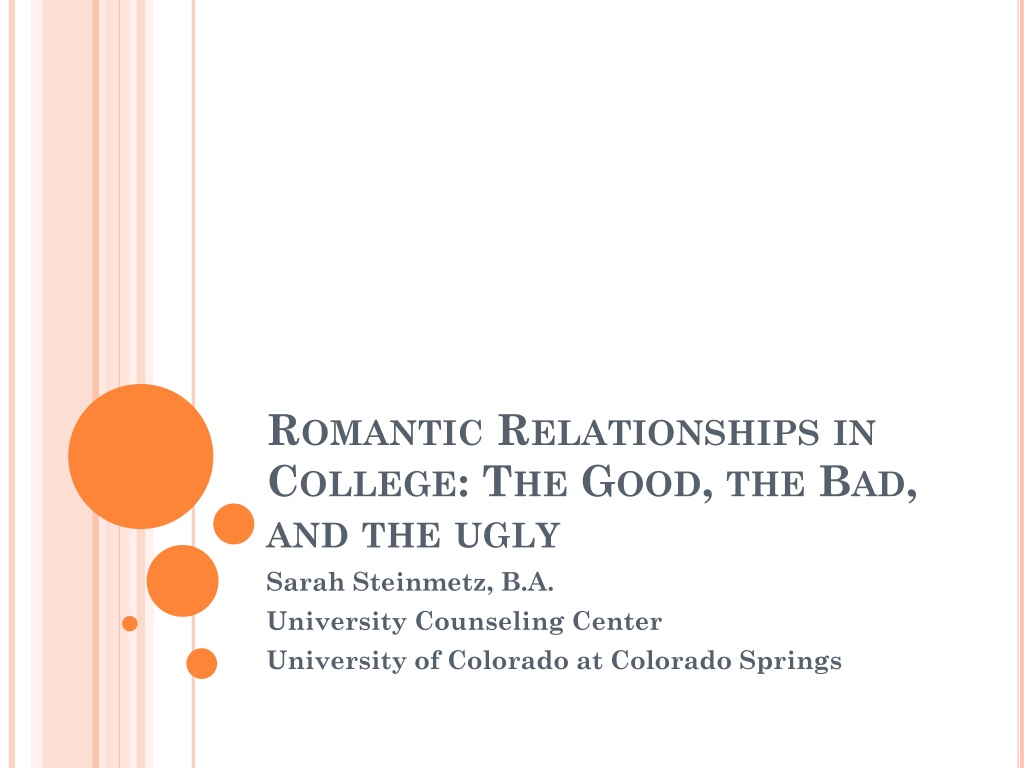
 undefined
undefined





















